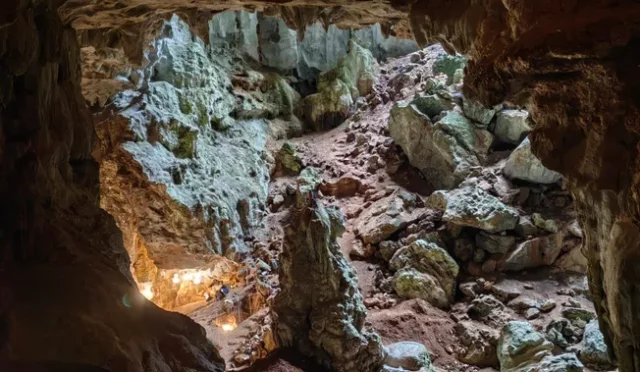Tens of thousands of years before modern humans dominion over the planet, there they were on a Laotian mountaintop. Though, it seems their lineages went extinct
Perched high on a mountain in Laos is Tam Pà Ling, the Cave of the Monkeys. More than a kilometer above sea level, it cuts deep into the soft bedrock, with a main chamber around 65 meters inside. Tam Pà Ling is inland and with just one cave mouth, it gets dark inside. Yet this remote cave is the place where archaeologists, who had to haul their gear up the mountain by foot, have now found the earliest modern humans to have reached the southeast Asian mainland.
A fragment of a skull and a leg-bone found in the deepest excavation layer, dating from 86,000 to 68,000 years ago, belonged to anatomically modern humans, write Sarah Friedline of the University of Central Florida with Laura Shackelford of the University of Illinois Urbana-Champaign, Fabrice Demeter of the University of Copenhagen and colleagues in Nature Communications.
The story actually began in 2009, when the same team and colleagues found other modern human remains in the cave – a skull, a jaw and some teeth, and they were startling enough. Analysis estimated them to be at least 46,000 years old, and possibly as old as 70,000 years. That find alone was enough to challenge theories of modern human dispersal.

The newly revealed fossils are at least 10,000 years older and support the thesis that modern humans were leaving Africa much earlier than had been thought – even if their migrations failed.
Failed means they went extinct, leaving no descendants in human populations today. “Successful” modern human exits from Africa would only begin shortly before 50,000 years ago, according to the state of theory today.
The older skull found in Tam Pa Ling is key to the interpretation. According to the authors, its gracility is a hallmark of we weedy Homo sapiens rather than an evolution of burlier human variants known to have been in the area.
- 8,000-year-old plans for animal mega-traps discovered in Saudi Arabia, Jordan
- King David’s Jerusalem wasn’t where we thought, new study argues
- 12,000-year-old flutes found in Israel may be earliest bird-call whistles in the world
Which variants? By the time these modern humans reached Laos, Homo erectus had apparently gone extinct. The latest erectus fossil known in the region was in Java and dates to about 108,000 years ago. However, Denisovans – a sister species to Neanderthals – were still around.
There is a theory that they hung on until as recently as 15,000 years ago, based on implications of genetic analyses (as opposed to fossil evidence). We can leave the “hobbit” types, of which two have been found so far, Homo floresiensis and Homo luzonensis, out of this discussion.
